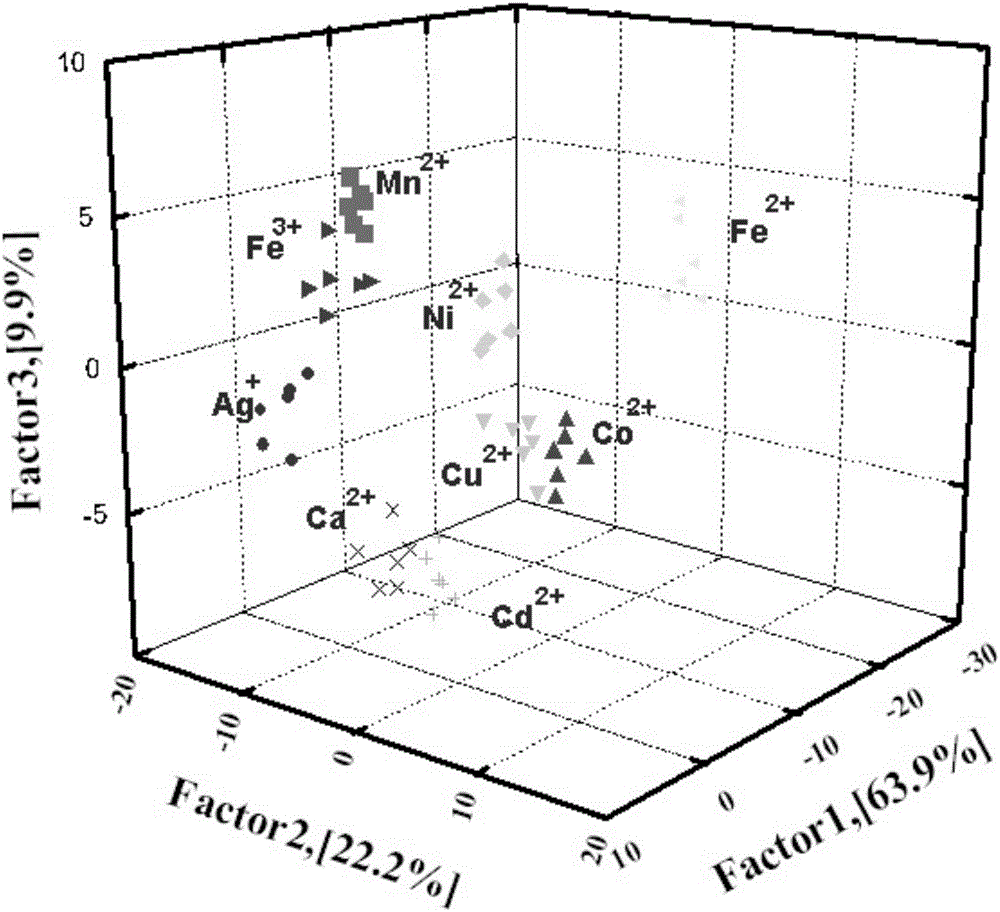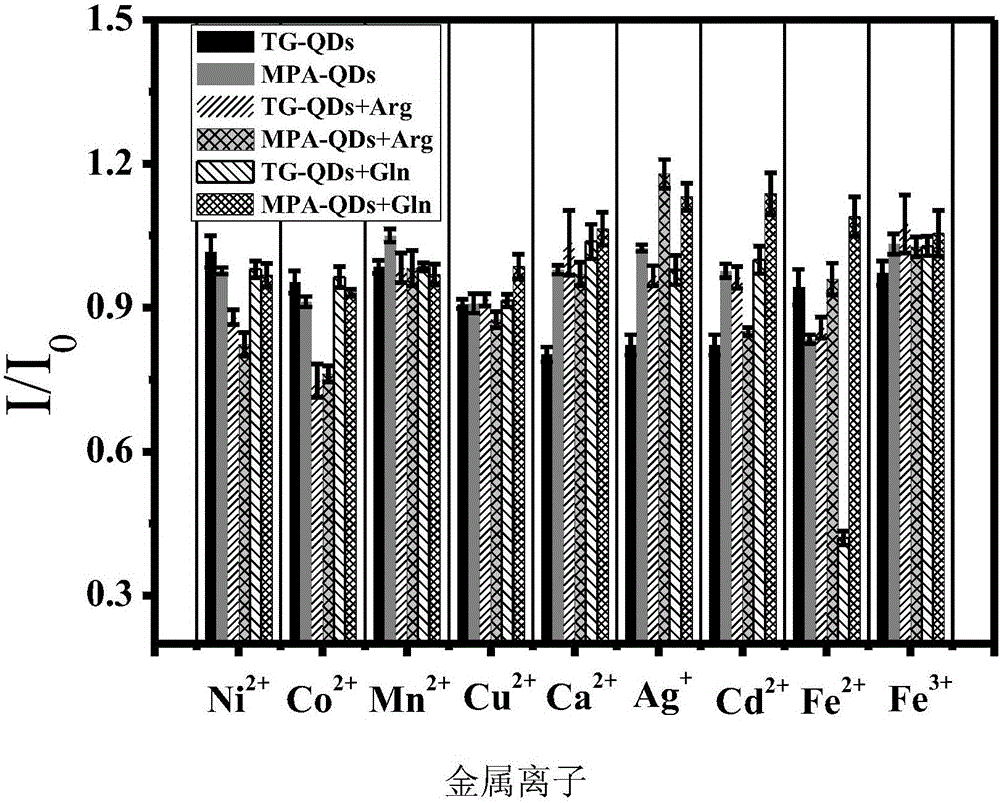Detection method for metal ions by amino acid regulated quantum dot fluorescent array sensor
An array sensor and detection method technology, applied in the field of optical analysis, can solve the problems of expensive instruments, high cost, cumbersome operation, etc., and achieve the effects of low detection limit, good linearity, and high sensitivity detection and identification
- Summary
- Abstract
- Description
- Claims
- Application Information
AI Technical Summary
Problems solved by technology
Method used
Image
Examples
Embodiment 1
[0036] Example 1: Preparation of Mn-doped ZnS quantum dots capped with mercaptopropionic acid
[0037] Preparation of 3-mercaptopropionic acid-capped Mn-ZnS quantum dots (MPA-QDs): ZnSO 4 ·7H 2 O (7.5mL, 0.1M), Mn(CH 3 COO) 2 4H 2 O (0.1 mL, 0.1 M) and mercaptopropionic acid MPA (0.26 mL) were added to a three-necked flask. The volume of the mixed solution was made up to 50 mL with ultrapure water, and adjusted to pH 10.3-10.5 with 10 M NaOH.
[0038] After removing the air by bubbling argon for 30 min at room temperature, the Na 2 S·9H 2O (7.5 mL, 0.1 M) was quickly injected into the solution. The mixture was stirred vigorously for 20 min and then for another 2 h at 50 °C to form MPA-QDs. For purification, the obtained QDs were precipitated with ethanol and separated by centrifugation (8000 rpm, 5 min). This ethanol precipitation-centrifugation process was repeated three times. Finally, the prepared MPA-QDs were dried in vacuum.
Embodiment 2
[0040] The operation of coating Mn-doped ZnS quantum dots with thioglycerol is:
[0041] 1.0M ZnSO 4 ·7H 2 O (5.0mL), 0.1M Mn(CH 3 COO) 2 4H 2 A solution of O (1.5 mL) was stirred at room temperature to obtain Mn 2+ Doped quantum dots; then mixed with 1.0M thioglycerol (TG, 20mL) and added to a three-necked flask. The volume of the mixed solution was replenished to 50 mL with ultrapure water, adjusted to pH 10.3 with 10 M NaOH and washed with N 2 Bubble for 30 minutes.
[0042] Then Na 2 S·9H 2 O aqueous solution (1.0 M, 4.5 mL) was quickly injected into the reaction flask, and the mixture was refluxed for 20 hours. After cooling to room temperature, it was separated from the aqueous solution by adding ethanol and by centrifugation, and the operation was the same as in Example 1. Wash with ethanol and dry under vacuum at room temperature.
Embodiment 3
[0044] Prepare the Mn-doped ZnS QDs coated with thioglycerol (TG) prepared in Example 2 to make a 200 μg / mL solution, take out 210 μL with a pipette tip and add it to a centrifuge tube, and then add the prepared 800 μM Arg Add 105 μL of the solution, then add 63 μL of ultrapure water, and finally add 42 μL of 10 μM metal ion solution, shake well on the shaker, take out 200 μL of the solution with a pipette tip and add it to a cuvette, using Edinburgh FLS-920 transient steady state The fluorescence spectrometer carries out fluorescence detection, and the transmitted light intensity is recorded as I (see figure 1 S5).
[0045] Detect the transmitted light intensity I of the blank solution when no metal ion solution is added 0 . Record the fluorescence spectrum data, and then use the data processing software (originlab) to process, such as figure 2 , using QDs and amino acids to construct six array units, adding a variety of metal ions, which can efficiently and quickly ident...
PUM
 Login to View More
Login to View More Abstract
Description
Claims
Application Information
 Login to View More
Login to View More - R&D
- Intellectual Property
- Life Sciences
- Materials
- Tech Scout
- Unparalleled Data Quality
- Higher Quality Content
- 60% Fewer Hallucinations
Browse by: Latest US Patents, China's latest patents, Technical Efficacy Thesaurus, Application Domain, Technology Topic, Popular Technical Reports.
© 2025 PatSnap. All rights reserved.Legal|Privacy policy|Modern Slavery Act Transparency Statement|Sitemap|About US| Contact US: help@patsnap.com



